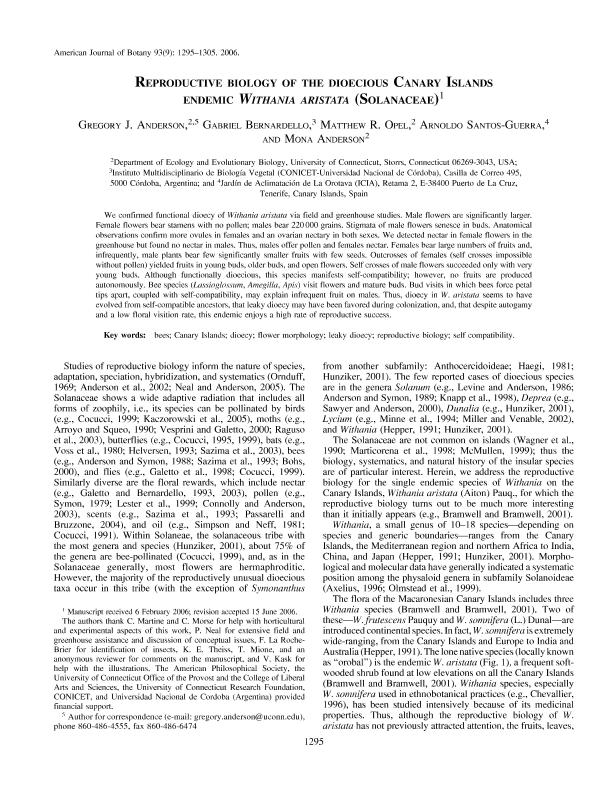Mostrar el registro sencillo del ítem
dc.contributor.author
Anderson, Gregory
dc.contributor.author
Bernardello, Gabriel Luis Mario

dc.contributor.author
Opel, Matthew R.
dc.contributor.author
Santos-Guerra, Arnoldo
dc.contributor.author
Anderson, Mona
dc.date.available
2018-01-04T17:41:43Z
dc.date.issued
2006-12
dc.identifier.citation
Anderson, Mona; Santos-Guerra, Arnoldo; Opel, Matthew R.; Bernardello, Gabriel Luis Mario; Anderson, Gregory; Reproductive biology of the dioecious Canary Islands endemic Withania aristata (Solanaceae); Botanical Society of America; American Journal of Botany; 93; 9; 12-2006; 1295-1305
dc.identifier.issn
0002-9122
dc.identifier.uri
http://hdl.handle.net/11336/32319
dc.description.abstract
We confirmed functional dioecy of Withania aristata via field and greenhouse studies. Male flowers are significantly larger. Female flowers bear stamens with no pollen; males bear 220 000 grains. Stigmata of male flowers senesce in buds. Anatomical observations confirm more ovules in females and an ovarian nectary in both sexes. We detected nectar in female flowers in the<br />greenhouse but found no nectar in males. Thus, males offer pollen and females nectar. Females bear large numbers of fruits and, infrequently, male plants bear few significantly smaller fruits with few seeds. Outcrosses of females (self crosses impossible without pollen) yielded fruits in young buds, older buds, and open flowers. Self crosses of male flowers succeeded only with very<br />young buds. Although functionally dioecious, this species manifests self-compatibility; however, no fruits are produced autonomously. Bee species (Lassioglossum, Amegilla, Apis) visit flowers and mature buds. Bud visits in which bees force petal tips apart, coupled with self-compatibility, may explain infrequent fruit on males. Thus, dioecy in W. aristata seems to have evolved from self-compatible ancestors, that leaky dioecy may have been favored during colonization, and, that despite autogamy and a low floral visition rate, this endemic enjoys a high rate of reproductive success.
dc.format
application/pdf
dc.language.iso
eng
dc.publisher
Botanical Society of America

dc.rights
info:eu-repo/semantics/openAccess
dc.rights.uri
https://creativecommons.org/licenses/by-nc-sa/2.5/ar/
dc.subject
Bees
dc.subject
Canary Islands
dc.subject
Dioecy
dc.subject
Leaky Dioecy
dc.subject.classification
Otras Ciencias Biológicas

dc.subject.classification
Ciencias Biológicas

dc.subject.classification
CIENCIAS NATURALES Y EXACTAS

dc.title
Reproductive biology of the dioecious Canary Islands endemic Withania aristata (Solanaceae)
dc.type
info:eu-repo/semantics/article
dc.type
info:ar-repo/semantics/artículo
dc.type
info:eu-repo/semantics/publishedVersion
dc.date.updated
2017-11-16T15:16:45Z
dc.identifier.eissn
1537-2197
dc.journal.volume
93
dc.journal.number
9
dc.journal.pagination
1295-1305
dc.journal.pais
Estados Unidos

dc.journal.ciudad
Saint Louis
dc.description.fil
Fil: Anderson, Gregory. University Of Connecticut; Estados Unidos
dc.description.fil
Fil: Bernardello, Gabriel Luis Mario. Consejo Nacional de Investigaciones Científicas y Técnicas. Centro Científico Tecnológico Conicet - Córdoba. Instituto Multidisciplinario de Biología Vegetal. Universidad Nacional de Córdoba. Facultad de Ciencias Exactas Físicas y Naturales. Instituto Multidisciplinario de Biología Vegetal; Argentina
dc.description.fil
Fil: Opel, Matthew R.. University Of Connecticut; Estados Unidos
dc.description.fil
Fil: Santos-Guerra, Arnoldo. Jardín de Aclimatación de La Orotava; España
dc.description.fil
Fil: Anderson, Mona. University Of Connecticut; Estados Unidos
dc.journal.title
American Journal of Botany

dc.relation.alternativeid
info:eu-repo/semantics/altIdentifier/url/http://www.amjbot.org/content/93/9/1295.full
Archivos asociados
